New Mars Forums
You are not logged in.
- Topics: Active | Unanswered
Announcement
#1 2016-05-03 21:04:42
- Tom Kalbfus
- Banned
- Registered: 2006-08-16
- Posts: 4,401
Can we use Lockheed's 100 Megawatt Fusion reactor for a Mars Mission?
http://nextbigfuture.com/2016/05/lockhe … still.html
May 03, 2016
Lockheed Portable Fusion proejct still making progress
energy, fusion, future, nuclear
Lockheed Martin continues to invest in its portable nuclear fusion generator, with that investment recently entering a more advanced stage, according to the head of the company’s Skunk Works division.
Rob Weiss told an audience at the Atlantic Council that Lockheed is “about four months into a little bit more significant investment” into the technology, which was first revealed around two years ago.
At the time of the initial announcement, Lockheed said it was aiming for a 100 megawatt device which could fit on the back of a large truck. Such a reactor, the company claims, could power a city of up to 100,000 people.
The project began in 2010.
In October 2014 Lockheed Martin announced that they will attempt to develop a compact fusion reactor that will fit "on the back of a truck" and produce 100 MW output - enough to power a town of 80,000 people.
Lockheed is using magnetic mirror confinement that contains the plasma in which fusion occurs by reflecting particles from high-density magnetic fields to low-density ones.
Lockheed is targeting a relatively small device that is approximately the size of a conventional jet engine. The prototype is approximately 1 meter by 2 meters in size.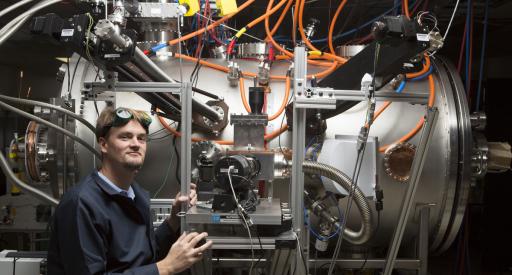
McGuire previously provided some technical and project details in late 2014. MIT Technology Review reports on the skepticism and critics of the Lockheed Martin approach. Ian Hutchinson, a professor of nuclear science and engineering at MIT and one of the principal investigators at the MIT fusion research reactor, says the type of confinement described by Lockheed had long been studied without much success.
McGuire acknowledged the need for shielding against neutrons for the magnet coils positioned inside the reactor vessel. He estimates that between 80 and 150 centimeters of shielding would be needed, but this can be accommodated in their compact design. Researchers contacted by ScienceInsider say that it is difficult to estimate the final size of the machine without more knowledge of its design. Lockheed has said its goal is a machine 7 meters across, but some estimates had suggested that the required shielding would make it considerably larger.
Magnetic Confinement with magnetic mirrors and recirculation of losses
Their magnetic confinement concept combined elements from several earlier approaches. The core of the device uses cusp confinement, a sort of magnetic trap in which particles that try to escape are pushed back by rounded, pillowlike magnetic fields. Cusp devices were investigated in the 1960s and 1970s but were largely abandoned because particles leak out through gaps between the various magnetic fields leading to a loss of temperature. McGuire says they get around this problem by encapsulating the cusp device inside a magnetic mirror device, a different sort of confinement technique. Cylindrical in shape, it uses a magnetic field to restrict particles to movement along its axis. Extra-strong fields at the ends of the machine—magnetic mirrors—prevent the particles from escaping. Mirror devices were also extensively studied last century, culminating in the 54-meter-long Mirror Fusion Test Facility B (MFTF-B) at Lawrence Livermore National Laboratory in California. In 1986, MFTF-B was completed at a cost of $372 million but, for budgetary reasons, was never turned on.
Another technique the team is using to counter particle losses from cusp confinement is recirculation.
Mirror Fusion Test Facility B
The Mirror Fusion Test Facility B followed the earlier Baseball II device, the facility was originally a similar system in which the confinement area was located between two horseshoe-shaped "mirrors". During construction, however, the success of the Tandem Mirror Experiment ("TMX") led to a redesign to insert a solenoid area between two such magnets, dramatically improving confinement time from a few milliseconds to over one second. Parts of the MFTF-B were reused. [A spheromak ignition experiment reusing Mirror Fusion Test Facility (MFTF) equipment].
Other earlier reports on fusion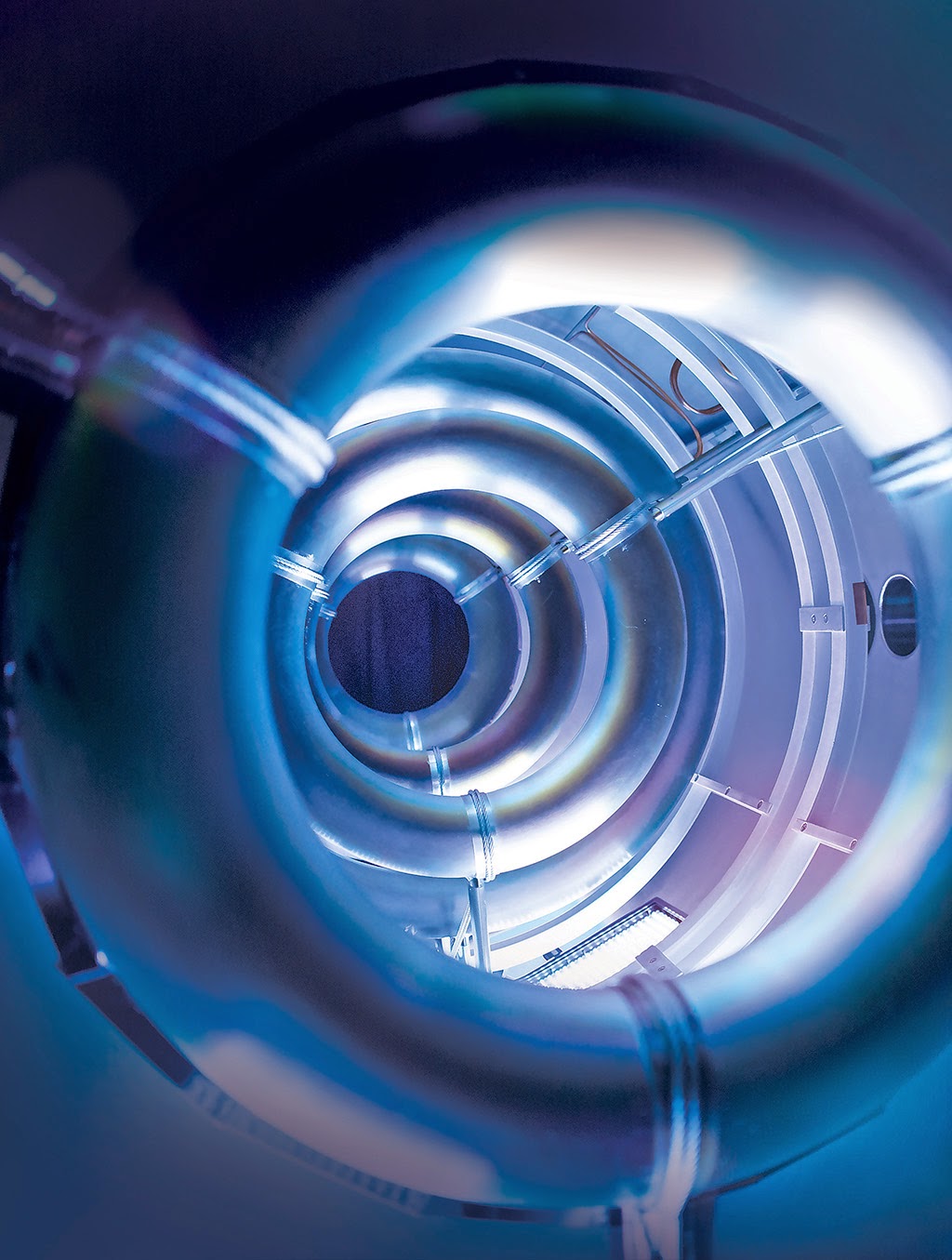
Superconductors inside magnetic rings will contain the plasma.Credit : Lockheed Martin
Initial work demonstrated the feasibility of building a 100-megawatt reactor measuring seven feet by 10 feet, which could fit on the back of a large truck, and is about 10 times smaller than current reactors.
The Lockheed 100MW compact fusion reactor would run on deuterium and tritium (isotopes of hydrogen).
Instead of the large tokomaks which will take until the mid-2040s or 2050s for the first one and which will be large (30,000 tons) and expensive have one that fit on a truck. Build on a production line like jet engines.
Aviation Week was given exclusive access to view the Skunk Works experiment, dubbed “T4,” first hand. Led by Thomas McGuire, an aeronautical engineer in the Skunk Work’s aptly named Revolutionary Technology Programs unit, the current experiments are focused on a containment vessel roughly the size of a business-jet engine. Connected to sensors, injectors, a turbopump to generate an internal vacuum and a huge array of batteries, the stainless steel container seems an unlikely first step toward solving a conundrum that has defeated generations of nuclear physicists—namely finding an effective way to control the fusion reaction.
The problem with tokamaks is that “they can only hold so much plasma, and we call that the beta limit,” McGuire says. Measured as the ratio of plasma pressure to the magnetic pressure, the beta limit of the average tokamak is low, or about “5% or so of the confining pressure,” he says. Comparing the torus to a bicycle tire, McGuire adds, “if they put too much in, eventually their confining tire will fail and burst—so to operate safely, they don’t go too close to that.”
The CFR will avoid these issues by tackling plasma confinement in a radically different way. Instead of constraining the plasma within tubular rings, a series of superconducting coils will generate a new magnetic-field geometry in which the plasma is held within the broader confines of the entire reaction chamber. Superconducting magnets within the coils will generate a magnetic field around the outer border of the chamber. “So for us, instead of a bike tire expanding into air, we have something more like a tube that expands into an ever-stronger wall,” McGuire says. The system is therefore regulated by a self-tuning feedback mechanism, whereby the farther out the plasma goes, the stronger the magnetic field pushes back to contain it. The CFR is expected to have a beta limit ratio of one. “We should be able to go to 100% or beyond,” he adds.
The Lockheed design “takes the good parts of a lot of designs.” It includes the high beta configuration, the use of magnetic field lines arranged into linear ring “cusps” to confine the plasma and “the engineering simplicity of an axisymmetric mirror,” he says. The “axisymmetric mirror” is created by positioning zones of high magnetic field near each end of the vessel so that they reflect a significant fraction of plasma particles escaping along the axis of the CFR. “We also have a recirculation that is very similar to a Polywell concept,” he adds, referring to another promising avenue of fusion power research. A Polywell fusion reactor uses electromagnets to generate a magnetic field that traps electrons, creating a negative voltage, which then attract positive ions. The resulting acceleration of the ions toward the negative center results in a collision and fusion. 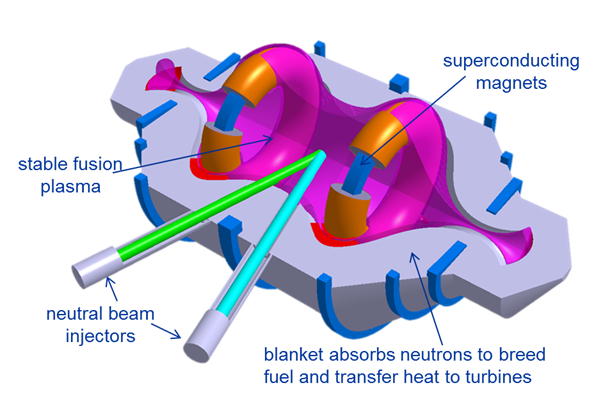
Neutrons released from plasma (colored purple in the picture) will transfer heat through the reactor walls. Credit : Lockheed Martin
Breakthrough technology: Charles Chase and his team at Lockheed have developed a High Beta configuration, which allows a compact reactor design and speedier development timeline (5 years instead of 30).
* The magnetic field increases the farther that you go out, which pushes the plasma back in.
* It also has very few open field lines (very few paths for the plasma to leak out)
* Very good arch curvature of the field lines
* The Lockheed system has a beta of about 1.
* This system is DT (deuterium - tritium)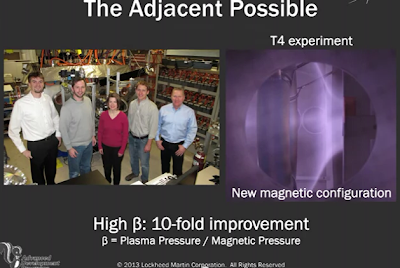
Credit : Lockheed Martin and Google Solve for X
McGuire said the company had several patents pending for the work and was looking for partners in academia, industry and among government laboratories to advance the work.
Currently a cylinder 1 meter wide and 2 meters tall. The 100 MW version would be about twice the dimensions.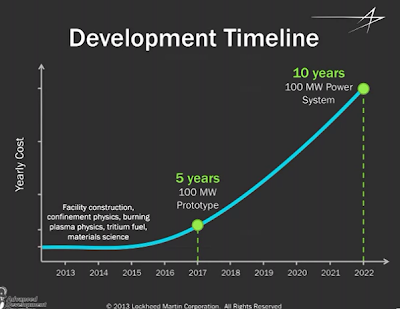
Credit : Lockheed Martin and Google Solve for X
Credit : Lockheed Martin and Google Solve for X
Commercialization Targets for Nuclear Fusion Projects
LPP Fusion (Lawrenceville Plasma Physics) - the target is to make LPP Fusion with a commercial system 4 years after net energy gain is proved. The hop is two years to prove net energy gain. Then 2019-2022 for a commercial reactor (2022 if we allow for 3 years of slippage). They could lower energy costs by ten times.
Lockheed Compact Fusion has a target date of 2024 and made big news recently with some technical details and an effort to get partners.
Offline
Like button can go here
#2 2016-05-04 05:02:10
- Antius
- Member
- From: Cumbria, UK
- Registered: 2007-05-22
- Posts: 1,003
Re: Can we use Lockheed's 100 Megawatt Fusion reactor for a Mars Mission?
If they can produce a power producing fusion reactor with power density in the range that they are claiming, it opens up a lot of possibilities. Transit between Earth and Mars could be achieved using Fusion-powered arc-jet cyclers. These could use atmospheric air as propellant. Hence, after the first cycler is delivered to LEO, all susequent mass delivered to LEO could be useful payload.
It also makes skyhooks a more practicable proposition, as the orbiting vehicle can achieve high thrust and high specific impulse without a radioactive power source. This makes an Earth-launch SSTO a far more plausible option, as the vehicles required dV drops by at least one third.
Offline
Like button can go here
#3 2016-05-05 10:58:06
- Tom Kalbfus
- Banned
- Registered: 2006-08-16
- Posts: 4,401
Re: Can we use Lockheed's 100 Megawatt Fusion reactor for a Mars Mission?
The thing is, this fusion reactor requires a vacuum, otherwise the charge plasma becomes a hot gas when it mixes with air and it can't be contained by a magnetic field if it is neutrally charged. So how do you mix air with a fusing plasma without spoiling the fusing plasma and ceasing the fusion reaction? Do you recover the energy by generating electricity and then heat the air electrically or with infrared lasers or something like that?
Maybe you need a plasma window, to maintain a vaccum on one side of it so the fusion reaction can continue, then you pass the plasma through the window in one direction and you use magnetic fields to prevent it from moving backwards, the plasma has a lot of heat energy from its fusion, it mixes with air, and that mixture becomes a higher density but lower energy plasma with greater thrust capable of pushing the rocket at multiple gees of acceleration. Above a certain altitude, you mix the fusion product with hydrogen to provide greater thrust while maximizing the impulse at that thrust. The fusion gases are deuterium and tritium, mix the helium that results with hydrogen to produce an incandescent "flame" in space that pushes the rocket forward.
Last edited by Tom Kalbfus (2016-05-05 11:02:48)
Offline
Like button can go here
#4 2016-05-05 14:26:55
- Antius
- Member
- From: Cumbria, UK
- Registered: 2007-05-22
- Posts: 1,003
Re: Can we use Lockheed's 100 Megawatt Fusion reactor for a Mars Mission?
The thing is, this fusion reactor requires a vacuum, otherwise the charge plasma becomes a hot gas when it mixes with air and it can't be contained by a magnetic field if it is neutrally charged. So how do you mix air with a fusing plasma without spoiling the fusing plasma and ceasing the fusion reaction? Do you recover the energy by generating electricity and then heat the air electrically or with infrared lasers or something like that
That's the general idea. A liquid-metal cooled fast reactor probably offers comparable or better power density, but who wants a dozen hot nuclear cores whizzing above their head? The easiest way of heating the air is with an electrical arc, not unlike a plasma cutter.
A workable low-cost fusion machine really does change everything. Human beings would no longer depend upon the sun. Pluto would be as habitable as Mars, the most distant Oort cloud comet a comfortable home. The keys to the universe, no less.
Last edited by Antius (2016-05-05 14:54:29)
Offline
Like button can go here
#5 2016-05-08 09:27:04
- GW Johnson
- Member
- From: McGregor, Texas USA
- Registered: 2011-12-04
- Posts: 6,104
- Website
Re: Can we use Lockheed's 100 Megawatt Fusion reactor for a Mars Mission?
I'd be awfully careful about speculating what a long-odds experiment in fusion might mean for space travel. Making no mistake about it, that's what the Lockheed mirror machine is, just like the Polywell device USN has been funding as a long-shot. What you are looking at is marketing hype, not verifiable achievement. Not yet. Lockheed and USN are both playing the long-shot but high-payoff game. Not much different than playing the lottery.
Even if either of these things actually works, there's still light years of distance between even a verifiably-working lab brassboard device, and a useful piece of reliable equipment that folks can employ "in the field". My experiences tell me that nearly all scientists, and far too many engineers are unaware of that disparity. While laymen might be forgiven such ignorance, technically-knowledgeable people cannot. Beware: believe results, not hype.
That being said, a relatively-compact fusion device would be a real game-changer, in many, many ways. What you have to understand is that at this stage of the game, there are suggestions, but no generally-agreed-upon plans, for how to extract the energy from such devices. That still remains to be done, once scientifically-verified excess-beyond-breakeven fusion has been demonstrated.
I hope somebody succeeds, and soon. But if they did succeed tomorrow, I wouldn't expect to see such things actually fielded during my remaining reasonably-expected lifetime, on the order of 2 decades.
GW
GW Johnson
McGregor, Texas
"There is nothing as expensive as a dead crew, especially one dead from a bad management decision"
Offline
Like button can go here
#6 2016-05-08 10:53:26
- Tom Kalbfus
- Banned
- Registered: 2006-08-16
- Posts: 4,401
Re: Can we use Lockheed's 100 Megawatt Fusion reactor for a Mars Mission?
Depends on how much of a hurry they are in. Scientists, especially those employed by NASA have a reputation of having too much patience, they are willing to fiddle with something endlessly NASA is busy planning its First Manned Mars Mission for the Second half of the 21st century, and maybe by the 22nd century, they will actually have a permanent base staffed by scientists. Well, I'm not going to live that long.
Offline
Like button can go here